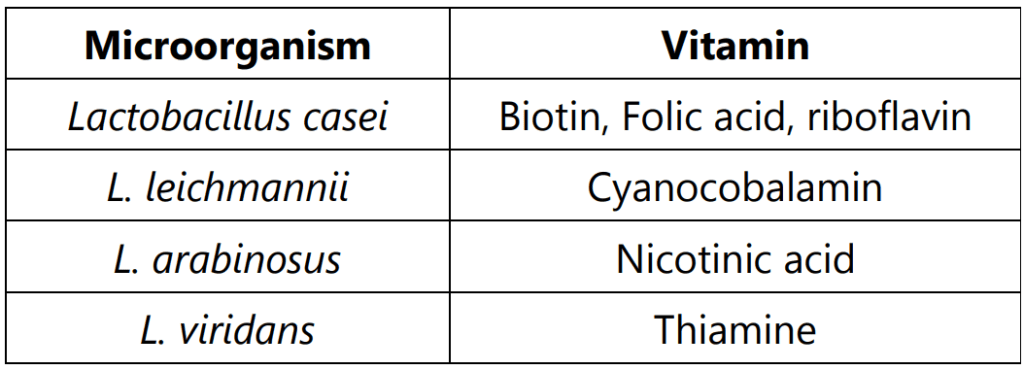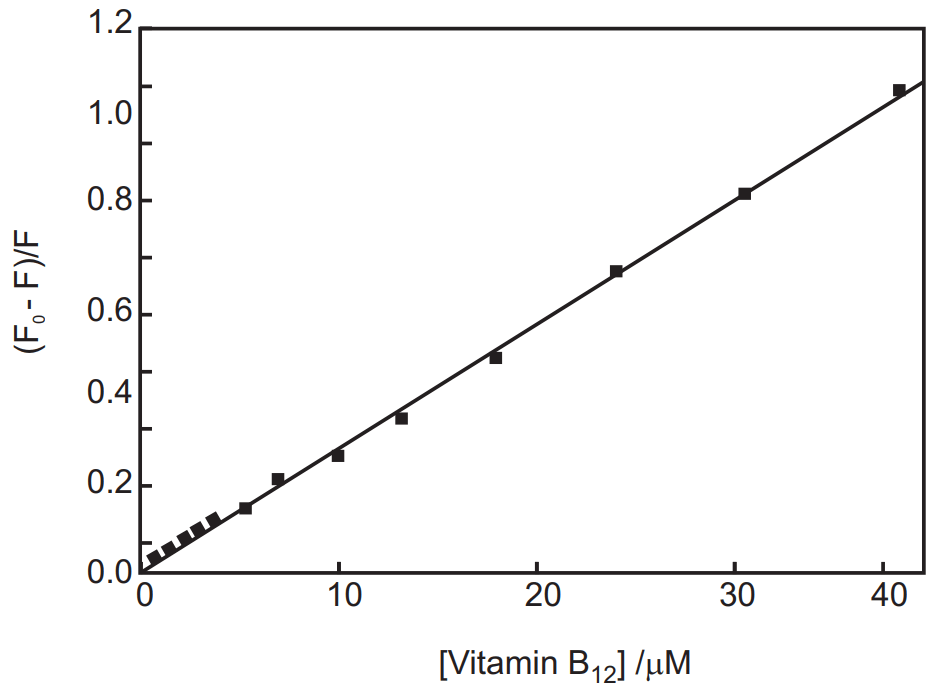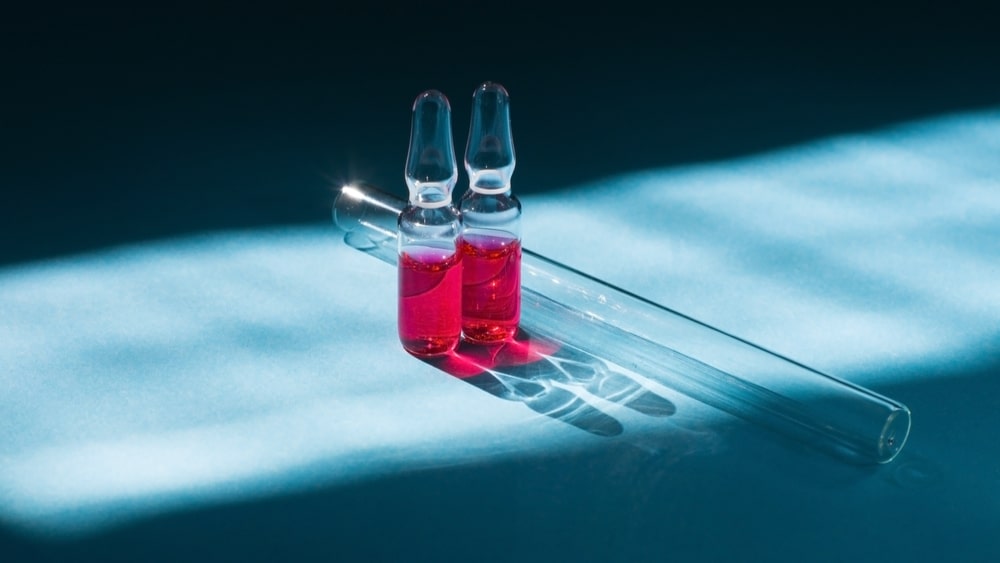Microbiological assay of vitamins is a biological assay method performed with the help of microorganisms. Vitamins and amino acids are the essential components for the growth of microorganisms. The basis of this assay is to measure the ability of the test organism to utilize the substance being assayed under a proper nutritional condition. Some examples of microorganisms used for the bioassay of vitamins are listed in Table 1.1.

Materials required
A stock solution, inoculum media, and assay medium are required. Finally, a standard curve is obtained.
Table of Contents
Assay of Vitamin B12
Vitamin B12 is also known as cyanocobalamin. It is a water-soluble vitamin. Its main sources are liver, eggs, milk, meat, and fish. Vitamin B12 deficiency causes Macrolytic anemia, Pernicious anemia.
Principle: The test organism selected is Lactobacillus liechmannii that is capable of utilizing free cyanocobalamin. The assay is performed by using the either titrimetric or turbidimetric method.
Preparation of Standard Stock Solution
An accurately weighed amount of Cyanocobalamin reference standard is added to sufficient 25% ethanol (resulting in a solution containing 1.0 µ g of cyanocobalamin per ml) and stored in the refrigerator. Further dilutions of this stock solution (1 µg/ ml) are made by adding 1 ml stock solution to 99 ml purified water (1 ml = 10 ng) and further adding 1 ml of the above solution to 199 ml purified water (1 ml = 0.05 ng).
Test Solution: Accurate amount of vitamin to be assayed is taken and dissolved in water, dilute HCl or NaOH is added to adjust pH at 6.0 and make up the volume with water up to the mark.
Inoculum Preparation: Transfer a loop full of Lactobacillus liechmannii from a recent sub-culture into two tubes each containing 10 ml of sterile culture medium.
Composition of culture media
Yeast extract – 0.75 gm
Peptone – 0.75 gm
Dextrose – 1 gm
Potassium dihydrogen phosphate – 0.2 gm
Tomato juice filtrate – 10 ml
Sorbitan monooleate solution – 1 ml
Water up to – 100 ml
Media is incubated for 18 to 24 hours at 37o C. The culture is centrifuged and decanted the supernatant fluid, under aseptic conditions. These cultured cells are suspended into 10 ml of a sterile suspension of Basal medium stock solution and again centrifuged and decanted off supernatant fluid. The cells are uniformly suspended in 10 ml of sterile medium and then aseptically transferred 1 ml of the cell suspension to 10 ml of sterile medium and mixed. Finally, this resulting cell suspension is taken as inoculum.
Assay Procedure
In clean ten test tubes, added 0, 0.5, 1.0, 2.0, 2.5, 3.0, 3.5, 4.0, 4.5, and 5 ml of standard cyanocobalamin solution. To each tube added 5 ml of Basal medium solution and the volume of each is adjusted to 10 ml by water. In another four test tubes added 1, 2, 3, 4 ml of test solution which is to be assayed. To each of these also added 5 ml of Basal medium stock solution and adjusted the volume to 10 ml with water. All test tubes are sterilized in an autoclave at 121o C for 15 minutes after that cooled the test tubes at room temperature. Inoculate a drop of inoculum prepared of Lactobacillus liechmannii and incubated the test tubes for 64 to 72 hours at the temperature range of 30 to 37o C. After incubation period titrated contents of each test tube with 0.05 N NaOH using bromothymol blue as indicator until a green color endpoint. Calculate the readings.
The average of titration values of each level of both standard and test solutions are determined and plotted on a graph considered average titration values (in ml) of 0.05 N NaOH against the concentration of standard cyanocobalamin solution. A linear graph is obtained by interpolating the standard curve to determine the concentration as activity per ml of vitamin B12. From the graph, the concentration of the test solution of cyanocobalamin is calculated (Fig. 1.1).

Assay of Calcium Pantothenate
It refers to the B complex vitamins (or vitamin B complex).
Standardized Stock Solution
Each ml of the stock solution consists of 50 mcg of calcium pantothenate. It is prepared by dissolving 50 mg of calcium pantothenate in 500 ml of double-distilled water as per British Pharmacopeial Chemical Reference Standard; 10 ml of 0.2 M acetic acid, 100 ml of 1.6% (w/v) sodium acetate; and volume made up to 1 liter with distilled water.
Standard Solution: The standard solution should contain approximately 0.04 mcg of calcium pantothenate in 1 ml, and is duly prepared by diluting the Standard Stock Solution.
Test Solution: The test solution contains nearly the same equivalent amount of calcium pantothenate as present in the Standard Solution i.e., 0.4 mcg/ml prepared in double-distilled water.
Culture Medium
The culture medium is composed of the following solutions and ingredients:
- Casein hydrolysate solution: 25 ml
- Cysteine-tryptophane solution : 25 ml
- Polysorbate-80 solution: 0.25 ml
- Dextrose (anhydrous): 10 g
- Sodium acetate (anhydrous): 5 g
- Adenine-guanine-uracil solution: 5 ml
- Riboflavin-Thiamine hydrochloride-Biotin Solution: 5 ml
- PABA-Niacin-Pyridoxine hydrochloride solution: 5 ml
- Calcium pantothenate solution A: 5 ml
- Calcium pantothenate solution B: 5 ml
The culture medium is usually prepared by dissolving both anhydrous dextrose and sodium acetate in previously mixed solutions and the pH is carefully adjusted to 6.8 with 1 M NaOH solution. The final volume is duly made up to 250 ml with distilled water and mixed thoroughly.
Stock Culture of Organism
The stock culture of the organism may be prepared to dissolve 2 g water-soluble yeast extract in 100 ml distilled water, 500 mg anhydrous dextrose, 500 mg anhydrous sodium acetate, and 1.5 g agar. The resulting mixture is heated gently so as to dissolve the agar. Now, 10 ml of hot solution is transferred to test tubes and sterilized at 121°C. The stab culture is now prepared duly in three tubes employing Lactobacillus Plantarum, incubated at 30 to 37°C for 16 to 24 hours, and stored in a refrigerator ultimately.
Preparation of Inoculum
The cells consequently obtained from the stock culture, organism (Lactobacillus Plantarum) are transferred to a sterile tube containing 10 ml of the culture medium and is incubated at 30 to 37°C for a duration of 16–24 hours. Methodology. The various steps involved are namely:
- Standard Solution is added to five test tubes in varying amounts viz., 1, 2, 3, 4, and 5 ml in duplicate.
- To each of the five above test tubes plus another four similar tubes without any standard solution is added 5 ml of culture medium, and the final volume made up to 10 ml with distilled water.
- Now, volumes of test solution corresponding to either three or more of the levels as taken above, are incorporated carefully to similar test tubes, in duplicate.
- To each test tube, 5 ml of the medium solution and volume is made up to 10 ml with distilled water.
- Tubes of both the series are duly heated in an autoclave at 121°C for 5 minutes, cooled to ambient temperature, and added 1 drop of inoculum to each tube except two of the four tubes that specifically has no ‘standard solution’ (i.e., the uninoculated tubes), and mixed thoroughly. The tubes are adequately incubated at 121°C at 30–37°C for 16– 24 hours.
- The absorbance of the various tubes is measured with a spectrophotometer at a wavelength ranging between 540–660 nm. A standard concentration-response curve is plotted between the transmittance Vs log ml (volume) of the standard solution in each tube. Finally, the exact concentration of the calcium pantothenate in the ‘test sample’ is determined with the help of the standard concentration-response curve.
Make sure you also check our other amazing Article on : Principles and Methods of Different Microbiological Assay
